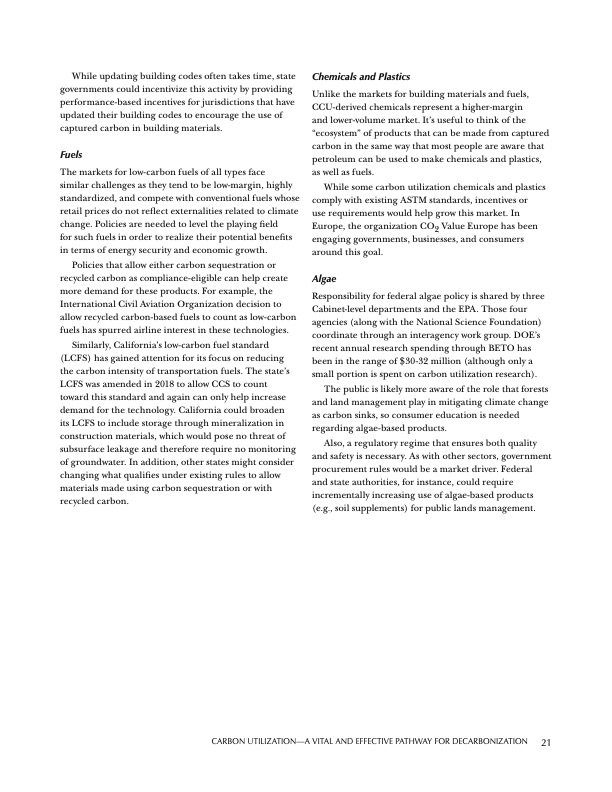
PDF Publication Title:
Text from PDF Page: 029
While updating building codes often takes time, state governments could incentivize this activity by providing performance-based incentives for jurisdictions that have updated their building codes to encourage the use of captured carbon in building materials. Fuels The markets for low-carbon fuels of all types face similar challenges as they tend to be low-margin, highly standardized, and compete with conventional fuels whose retail prices do not reflect externalities related to climate change. Policies are needed to level the playing field for such fuels in order to realize their potential benefits in terms of energy security and economic growth. Policies that allow either carbon sequestration or recycled carbon as compliance-eligible can help create more demand for these products. For example, the International Civil Aviation Organization decision to allow recycled carbon-based fuels to count as low-carbon fuels has spurred airline interest in these technologies. Similarly, California’s low-carbon fuel standard (LCFS) has gained attention for its focus on reducing the carbon intensity of transportation fuels. The state’s LCFS was amended in 2018 to allow CCS to count toward this standard and again can only help increase demand for the technology. California could broaden its LCFS to include storage through mineralization in construction materials, which would pose no threat of subsurface leakage and therefore require no monitoring of groundwater. In addition, other states might consider changing what qualifies under existing rules to allow materials made using carbon sequestration or with recycled carbon. Chemicals and Plastics Unlike the markets for building materials and fuels, CCU-derived chemicals represent a higher-margin and lower-volume market. It’s useful to think of the “ecosystem” of products that can be made from captured carbon in the same way that most people are aware that petroleum can be used to make chemicals and plastics, as well as fuels. While some carbon utilization chemicals and plastics comply with existing ASTM standards, incentives or use requirements would help grow this market. In Europe, the organization CO2 Value Europe has been engaging governments, businesses, and consumers around this goal. Algae Responsibility for federal algae policy is shared by three Cabinet-level departments and the EPA. Those four agencies (along with the National Science Foundation) coordinate through an interagency work group. DOE’s recent annual research spending through BETO has been in the range of $30-32 million (although only a small portion is spent on carbon utilization research). The public is likely more aware of the role that forests and land management play in mitigating climate change as carbon sinks, so consumer education is needed regarding algae-based products. Also, a regulatory regime that ensures both quality and safety is necessary. As with other sectors, government procurement rules would be a market driver. Federal and state authorities, for instance, could require incrementally increasing use of algae-based products (e.g., soil supplements) for public lands management. CARBON UTILIZATION—A VITAL AND EFFECTIVE PATHWAY FOR DECARBONIZATION 21PDF Image | Carbon Utilization

PDF Search Title:
Carbon UtilizationOriginal File Name Searched:
carbon-utilization-a-vital-and-effective-pathway-for-decarbonization.pdfDIY PDF Search: Google It | Yahoo | Bing
NFT (Non Fungible Token): Buy our tech, design, development or system NFT and become part of our tech NFT network... More Info
IT XR Project Redstone NFT Available for Sale: NFT for high tech turbine design with one part 3D printed counter-rotating energy turbine. Be part of the future with this NFT. Can be bought and sold but only one design NFT exists. Royalties go to the developer (Infinity) to keep enhancing design and applications... More Info
Infinity Turbine IT XR Project Redstone Design: NFT for sale... NFT for high tech turbine design with one part 3D printed counter-rotating energy turbine. Includes all rights to this turbine design, including license for Fluid Handling Block I and II for the turbine assembly and housing. The NFT includes the blueprints (cad/cam), revenue streams, and all future development of the IT XR Project Redstone... More Info
Infinity Turbine ROT Radial Outflow Turbine 24 Design and Worldwide Rights: NFT for sale... NFT for the ROT 24 energy turbine. Be part of the future with this NFT. This design can be bought and sold but only one design NFT exists. You may manufacture the unit, or get the revenues from its sale from Infinity Turbine. Royalties go to the developer (Infinity) to keep enhancing design and applications... More Info
Infinity Supercritical CO2 10 Liter Extractor Design and Worldwide Rights: The Infinity Supercritical 10L CO2 extractor is for botanical oil extraction, which is rich in terpenes and can produce shelf ready full spectrum oil. With over 5 years of development, this industry leader mature extractor machine has been sold since 2015 and is part of many profitable businesses. The process can also be used for electrowinning, e-waste recycling, and lithium battery recycling, gold mining electronic wastes, precious metals. CO2 can also be used in a reverse fuel cell with nafion to make a gas-to-liquids fuel, such as methanol, ethanol and butanol or ethylene. Supercritical CO2 has also been used for treating nafion to make it more effective catalyst. This NFT is for the purchase of worldwide rights which includes the design. More Info
NFT (Non Fungible Token): Buy our tech, design, development or system NFT and become part of our tech NFT network... More Info
Infinity Turbine Products: Special for this month, any plans are $10,000 for complete Cad/Cam blueprints. License is for one build. Try before you buy a production license. May pay by Bitcoin or other Crypto. Products Page... More Info
| CONTACT TEL: 608-238-6001 Email: greg@infinityturbine.com | RSS | AMP |